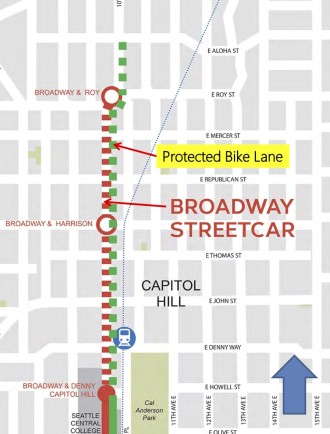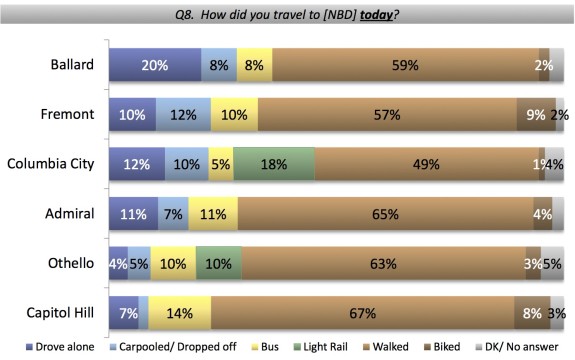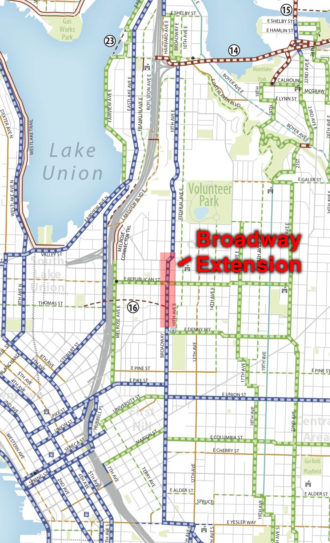Don’t stop the Broadway streetcar and bikeway now

From a June 2015 SDOT/Alta presentation to the Seattle Bicycle Advisory Board
Today, the First Hill Streetcar and Broadway Bikeway end unceremoniously at Denny Way just before reaching the North Broadway business district. People biking are forced to choose between merging into mixed traffic on the busy commercial street, trying to navigate using side streets with poor business access and poor crossings at busy streets like John/Olive, or riding on packed sidewalks.
Not only are all these options bad for bike access to North Broadway businesses, they also undercut the usefulness of the existing stretch of the bikeway extending south to Pike/Pine, Seattle U, First Hill medical centers and Yesler Terrace.
The Broadway Bikeway will be be an incomplete bike route until the city extends it beyond Roy, as the city has planned. The project has $14 million in grant funding, and the current plan calls for the remaining $10 million to come from a local improvement district.
But the Capitol Hill Chamber of Commerce pushed back on the Broadway extension plans in December, according to Capitol Hill Seattle.
"If we want to see Broadway thrive " the streetcar is actually the best way to undermine that," the Chamber's Executive Director Sierra Hansen told CHS. Hansen singled out the bikeway for conflicting with delivery vehicles:
The design is about 90% complete, SDOT's transit mobility director Andrew Glass Hastings said, which also includes extending the separated Broadway bikeway. As the plan is right now, Hansen said the design would negatively impact businesses.
"It would basically gut access to businesses on Broadway," she said.
The extension plan includes removal of another handful of left turns on Broadway, restricting mobility, Hansen said. She said access for delivery trucks is a particular concern as they are already dealing with difficulties on Broadway and at times park in the bikeway to make a delivery.
"The design is seriously flawed because it limits the access of panel trucks, which are the lifeblood of these businesses," Hansen said.

From a 2012 Seattle customer survey. Even before Capitol Hill Station, the streetcar and the Broadway Bikeway opened, biking, walking and transit were already the primary ways people accessed Capitol Hill businesses.

Context as part of the city's Bicycle Master Plan.
Of course, panel trucks are not the lifeblood of businesses. Customers are. And improving access to businesses for people biking, walking and taking transit should be seen as the most vital growth strategy for a business district where relatively few customers arrive by car to battle for parking spaces.
As a part of a bold complete streets redesign of the street, the bikeway will come with extended crosswalk bulbs and islands to make getting across Broadway safer and more comfortable. Transit islands also free up sidewalk space for people walking along Broadway by giving people waiting for the bus or streetcar a space to do so.
Conflicts between deliveries and the bikeway need to be addressed, we agree. Working together, the city can surely come up with ways to make sure the necessary loading zones are available. Because while some delivery drivers park in bike lanes because they don't care about bike lanes, others park in them because they have a job to do and there's nowhere else to stop. This is a problem of loading zone strategy (and porous bike lane barriers), not a reason to stop building safe bike access to your business district.
Business owners wary of the bikeway should take a zoomed-out view of the bike network. A comfortable and safe bike connection on Pike and/or Pine between downtown and Broadway is among the most needed bike investments Seattle can make. Once complete (hopefully well before the streetcar extension is finished), the Broadway Bikeway will be part of a network connecting most of the city's dense central neighborhoods right to the front doors of businesses on North Broadway.
The Broadway Bikeway that exists today is held back by the city's piecemeal methods for building transportation infrastructure. It's an island of bikeability that ends abruptly before serving a major destination area. But it is a central part of the future network that safe streets advocates are working hard to connect as soon as possible.
Many more people would bike to North Broadway businesses if the way there were comfortable and safe.
As for the streetcar part of the project, that was always the least-exciting part of the Broadway remake. But it sure seems silly to build it this far only to stop before serving North Broadway businesses. Plus, it would be a shame to throw away the $14 million in Federal grants the city has lined up to help remake the street.
Below is a zoomed-out overview of the plans. You can see more granular block-by-block details in our previous post about the project.
